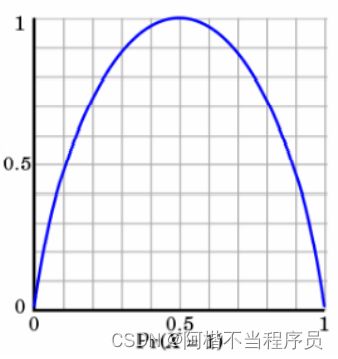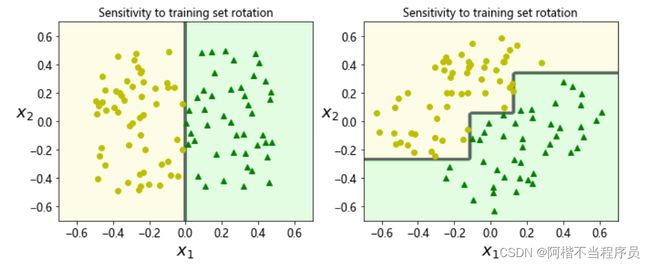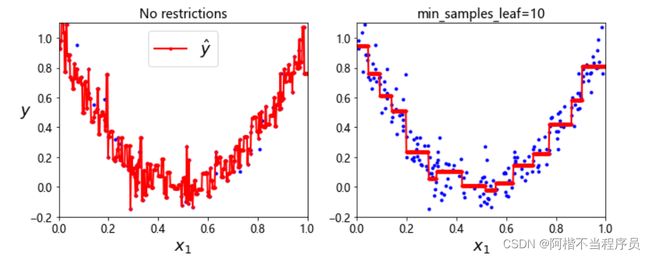机器学习—决策树
决策树
-
- 树模型可视化展示
- 决策边界展示
- 概率估计
- 决策树中的正则化
- 对数据的敏感
- 回归任务
- 从根节点开始一步一步走到叶子节点(决策)
- 所有的数据最终都会落到叶子节点,既可以做分类也可以做回归
根节点的决策应较强。
- 树的组成
根节点:第一个节点
非叶子结点与分支:中间过程
叶子结点:最终的决策结果
- 决策树的训练与测试
训练阶段:从给定的训练集构造出来一棵树(从根节点开始选择合适的特征,按优先级进行排列)
测试阶段:根据构造出来的树模型从上到下走一遍
- 如何切分特征(选择节点)
问题:根节点的选择该用哪个特征?接下来如何切分?
应该根据分类效果来排列先后顺序。
目标:通过一种衡量标准,来计算通过不同特征进行分支选择后的分类情况,找出来最好的那个当成根节点,以此类推。
- 熵
表示随机变量不确定性的度量,即物体内部的混乱程度。
H ( X ) = − ∑ p i ∗ l o g p i , i = 1 , 2 , . . . , n p i 为概率,当概率越大时,熵值越小 H(X) = - \sum pi * logpi,i=1,2,...,n \\[2ex] pi为概率,当概率越大时,熵值越小 H(X)=−∑pi∗logpi,i=1,2,...,npi为概率,当概率越大时,熵值越小
如: A = { 1 , 1 , 1 , 1 , 1 , 1 , 1 , 2 , 2 } A = \{1,1,1,1,1,1,1,2,2\} A={1,1,1,1,1,1,1,2,2},$ B = {1,2,3,4,5,6,7,8,9}$
A集合中的类别少,熵值低;B集合中类别多,熵值高。
在分类任务中,通过节点分支后数据类别的熵值越小为好。
如图,不确定性越大,得到的熵值也就越大:
当p=0或p=1时, H ( p ) = 0 H(p) = 0 H(p)=0,随机变量完全没有不确定性。
当p=0.5时, H ( p ) = 1 H(p)=1 H(p)=1,此时随机变量的不确定性最大。
- 信息增益
表示特征X使得类Y的不确定性减少的程度。
选择信息增益高的作为优先节点。
- 决策树算法
ID3:信息增益
C4.5:信息增益率(解决ID3问题,考虑自身熵)
CART:使用GINI系数来当做衡量标准
GINI系数: G i n i ( p ) = ∑ k = 1 k p k ( 1 − p k ) = 1 − ∑ k = 1 k p k 2 Gini(p) = \sum_{k=1}^{k}p_k(1-p_k) = 1-\sum_{k=1}^{k}p_k^2 Gini(p)=∑k=1kpk(1−pk)=1−∑k=1kpk2
- 连续值怎么办?
连续值离散化:对数据进行排序,然后选取分界点(若为二分类)。
60 , 70 , 75 , 85 , 90 , 95 , 100 , 120 , 125 , 220 60,70,75,85,90,95,100,120,125,220 60,70,75,85,90,95,100,120,125,220
如: 60 ∣ 70 , 75 , 85 , 90 , 95 , 100 , 120 , 125 , 220 60|70,75,85,90,95,100,120,125,220 60∣70,75,85,90,95,100,120,125,220,将60作为分界点,计算熵值;
60 , 70 ∣ 75 , 85 , 90 , 95 , 100 , 120 , 125 , 220 60,70|75,85,90,95,100,120,125,220 60,70∣75,85,90,95,100,120,125,220,将70作为分界点,计算熵值;
依次切分,比较即可得。
- 剪枝策略(避免过拟合)
决策树过拟合风险很大,理论上可以完全分得开数据。
将数据分支到极致,即分到结点只有一个样本,就造成了过拟合。
预剪枝:边建立决策树边进行剪枝的操作(更实用)。
限制深度(选取的特征个数)、叶子结点个数、叶子结点样本数、信息增益量等。
控制决策树的规模和复杂程度。
后剪枝:当建立完成决策树后来进行剪枝操作。
通过一定的衡量标准, C α ( T ) = C ( T ) + α ⋅ ∣ T l e a f ∣ C_α(T)=C(T)+α·|T_{leaf}| Cα(T)=C(T)+α⋅∣Tleaf∣(损失=熵值+平衡系数*叶子结点个数)
- 回归问题
利用方差来比较连续值的划分。
树模型可视化展示
- 用莺尾花数据集进行展示
# 导入数据集和模型
from sklearn.datasets import load_iris
from sklearn.tree import DecisionTreeClassifier
iris = load_iris()
X = iris.data[:,2:] # 选择2,3列数据
y = iris.target
tree_clf = DecisionTreeClassifier(max_depth=2) # 最大深度
tree_clf.fit(X,y)
# 生成决策树模型的图片
from sklearn.tree import export_graphviz
export_graphviz(
tree_clf, # 模型
out_file = "iris_tree.dot",
feature_names = iris.feature_names[2:], # 特征名
class_names = iris.target_names, # y值的名字
rounded = True,
filled = True
)
会生成一个.dot的文件,然后用此命令,转为png文件:
dot -Tpng iris_tree.dot -o iris_tree.png
# 图片展示
from IPython.display import Image
Image(filename='iris_tree.png',width=400,height=400)
决策边界展示
from matplotlib.colors import ListedColormap
def plot_decision_boundary(clf, X, y, axes=[0, 7.5, 0, 3], iris=True, legend=False, plot_training=True):
x1s = np.linspace(axes[0], axes[1], 100) # 构造特征
x2s = np.linspace(axes[2], axes[3], 100)
x1, x2 = np.meshgrid(x1s, x2s) # 棋盘
X_new = np.c_[x1.ravel(), x2.ravel()] # 测试集
y_pred = clf.predict(X_new).reshape(x1.shape) # 预测值
custom_cmap = ListedColormap(['#fafab0','#9898ff','#a0faa0'])
plt.contourf(x1, x2, y_pred, alpha=0.3, cmap=custom_cmap)
if not iris:
custom_cmap2 = ListedColormap(['#7d7d58','#4c4c7f','#507d50'])
plt.contour(x1, x2, y_pred, cmap=custom_cmap2, alpha=0.8)
if plot_training: # 画图:训练数据
plt.plot(X[:, 0][y==0], X[:, 1][y==0], "yo", label="Iris-Setosa")
plt.plot(X[:, 0][y==1], X[:, 1][y==1], "bs", label="Iris-Versicolor")
plt.plot(X[:, 0][y==2], X[:, 1][y==2], "g^", label="Iris-Virginica")
plt.axis(axes)
if iris:
plt.xlabel("Petal length", fontsize=14)
plt.ylabel("Petal width", fontsize=14)
else:
plt.xlabel(r"$x_1$", fontsize=18)
plt.ylabel(r"$x_2$", fontsize=18, rotation=0)
if legend:
plt.legend(loc="lower right", fontsize=14)
plt.figure(figsize=(8, 4))
plot_decision_boundary(tree_clf, X, y)
plt.plot([2.45, 2.45], [0, 3], "k-", linewidth=2) # 分割线
plt.plot([2.45, 7.5], [1.75, 1.75], "k--", linewidth=2)
plt.plot([4.95, 4.95], [0, 1.75], "k:", linewidth=2)
plt.plot([4.85, 4.85], [1.75, 3], "k:", linewidth=2)
plt.text(1.40, 1.0, "Depth=0", fontsize=15)
plt.text(3.2, 1.80, "Depth=1", fontsize=13)
plt.text(4.05, 0.5, "(Depth=2)", fontsize=11)
plt.title('Decision Tree decision boundaries')
plt.show()
概率估计
- 通过输入特征值,获取概率值或预测值
# 预测概率值
tree_clf.predict_proba([[5,1.5]]) # 分别返回属于三个类别的概率
# array([[0. , 0.90740741, 0.09259259]])
# 预测值
tree_clf.predict([[5,1.5]])
# array([1])
输入数据为:花瓣长5厘米,宽1.5厘米的花。
相应的叶节点是深度为2的左节点,因此决策树应输出以下概率:
- Iris-Setosa 为 0%(0/54),
- Iris-Versicolor 为 90.7%(49/54),
- Iris-Virginica 为 9.3%(5/54)。
最终预测值为1分类。
决策树中的正则化
- DecisionTreeClassifier参数:
min_samples_split:节点在分割之前最小样本数
min_samples_leaf:叶子节点最小样本数
max_leaf_nodes:叶子节点的最多个数( n 0 n_0 n0)
max_features:在每个节点处评估用于拆分的最大特征数
max_depth:树最大的深度
- 对比实验
# 导入数据集
from sklearn.datasets import make_moons
X,y = make_moons(n_samples=100,noise=0.25,random_state=53)
tree_clf1 = DecisionTreeClassifier(random_state=42)
tree_clf2 = DecisionTreeClassifier(min_samples_leaf=4,random_state=42)
# 训练
tree_clf1.fit(X,y)
tree_clf2.fit(X,y)
plt.figure(figsize=(12,4))
plt.subplot(121)
plot_decision_boundary(tree_clf1,X,y,axes=[-1.5,2.5,-1,1.5],iris=False)
plt.title('No restriction')
plt.subplot(122)
plot_decision_boundary(tree_clf2,X,y,axes=[-1.5,2.5,-1,1.5],iris=False)
plt.title('min_samples_leaf=4')
左图不做限制时,决策边界较为复杂,且右下角黄点,明显的形成了过拟合;
而限制了叶子结点最小样本数后,效果改善。
对数据的敏感
- 将数据集进行旋转之后的效果
# 构造数据集
np.random.seed(6)
Xs = np.random.rand(100,2) - 0.5
ys = (Xs[:,0] > 0).astype(np.float32) * 2
# 旋转角度
angle = np.pi/4
# 旋转矩阵
rotation_matrix = np.array([[np.cos(angle),-np.sin(angle)],[np.sin(angle),np.cos(angle)]])
# 旋转数据集
Xsr = Xs.dot(rotation_matrix)
# 原始数据集
tree_clf_s = DecisionTreeClassifier(random_state=42)
tree_clf_s.fit(Xs,ys)
# 旋转后数据集
tree_clf_sr = DecisionTreeClassifier(random_state=42)
tree_clf_sr.fit(Xsr,ys)
# 画图
plt.figure(figsize=(11,4))
plt.subplot(121)
plot_decision_boundary(tree_clf_s,Xs,ys,axes=[-0.7,0.7,-0.7,0.7],iris=False)
plt.title('Sensitivity to training set rotation')
plt.subplot(122)
plot_decision_boundary(tree_clf_sr,Xsr,ys,axes=[-0.7,0.7,-0.7,0.7],iris=False)
plt.title('Sensitivity to training set rotation')
plt.show()
将数据集进行旋转之后,决策边界也会发生改变。
回归任务
- 决策树也能做回归的任务
# 构造数据集
np.random.seed(42)
m = 200
X = np.random.rand(m,1)
y = 4*(X-0.5)**2
y = y + np.random.randn(m,1)/10 # 高斯,数据分布抖动
# 导入决策树回归模型
from sklearn.tree import DecisionTreeRegressor
tree_reg = DecisionTreeRegressor(max_depth=2)
tree_reg.fit(X,y)
export_graphviz(
tree_reg,
out_file=("regression_tree.dot"),
feature_names=["x1"],
rounded = True,
filled = True
)
将dot文件转成png文件:
dot -T png regression_tree.dot -o regreesion_tree.png
# 图片展示
from IPython.display import Image
Image(filename="regreesion_tree.png",width=600,height=600)
在进行回归任务时,可以选择参数来进行分裂,一般情况下都以均方误差,通过比较与均值的距离来进行树的分裂;
且为二叉树,所用模型为回归树(CART)。
- 回归任务中,树的深度对结果的影响
from sklearn.tree import DecisionTreeRegressor
# 构造两个树模型,其深度不同
tree_reg1 = DecisionTreeRegressor(random_state=42, max_depth=2)
tree_reg2 = DecisionTreeRegressor(random_state=42, max_depth=3)
tree_reg1.fit(X, y)
tree_reg2.fit(X, y)
# 预测值画图
def plot_regression_predictions(tree_reg, X, y, axes=[0, 1, -0.2, 1], ylabel="$y$"):
x1 = np.linspace(axes[0], axes[1], 500).reshape(-1, 1)
y_pred = tree_reg.predict(x1)
plt.axis(axes)
plt.xlabel("$x_1$", fontsize=18)
if ylabel:
plt.ylabel(ylabel, fontsize=18, rotation=0)
plt.plot(X, y, "b.")
plt.plot(x1, y_pred, "r.-", linewidth=2, label=r"$\hat{y}$")
plt.figure(figsize=(11, 4))
plt.subplot(121)
plot_regression_predictions(tree_reg1, X, y)
for split, style in ((0.1973, "k-"), (0.0917, "k--"), (0.7718, "k--")):
plt.plot([split, split], [-0.2, 1], style, linewidth=2)
plt.text(0.21, 0.65, "Depth=0", fontsize=15)
plt.text(0.01, 0.2, "Depth=1", fontsize=13)
plt.text(0.65, 0.8, "Depth=1", fontsize=13)
plt.legend(loc="upper center", fontsize=18)
plt.title("max_depth=2", fontsize=14)
plt.subplot(122)
plot_regression_predictions(tree_reg2, X, y, ylabel=None)
for split, style in ((0.1973, "k-"), (0.0917, "k--"), (0.7718, "k--")):
plt.plot([split, split], [-0.2, 1], style, linewidth=2)
for split in (0.0458, 0.1298, 0.2873, 0.9040):
plt.plot([split, split], [-0.2, 1], "k:", linewidth=1)
plt.text(0.3, 0.5, "Depth=2", fontsize=13)
plt.title("max_depth=3", fontsize=14)
plt.show()
树的深度越高,切分的越细。
- 叶子结点最小样本个数的不同
# 叶子结点最小样本个数的不同
tree_reg1 = DecisionTreeRegressor(random_state=42)
tree_reg2 = DecisionTreeRegressor(random_state=42, min_samples_leaf=10)
tree_reg1.fit(X, y)
tree_reg2.fit(X, y)
x1 = np.linspace(0, 1, 500).reshape(-1, 1)
y_pred1 = tree_reg1.predict(x1)
y_pred2 = tree_reg2.predict(x1)
plt.figure(figsize=(11, 4))
plt.subplot(121)
plt.plot(X, y, "b.")
plt.plot(x1, y_pred1, "r.-", linewidth=2, label=r"$\hat{y}$")
plt.axis([0, 1, -0.2, 1.1])
plt.xlabel("$x_1$", fontsize=18)
plt.ylabel("$y$", fontsize=18, rotation=0)
plt.legend(loc="upper center", fontsize=18)
plt.title("No restrictions", fontsize=14)
plt.subplot(122)
plt.plot(X, y, "b.")
plt.plot(x1, y_pred2, "r.-", linewidth=2, label=r"$\hat{y}$")
plt.axis([0, 1, -0.2, 1.1])
plt.xlabel("$x_1$", fontsize=18)
plt.title("min_samples_leaf={}".format(tree_reg2.min_samples_leaf), fontsize=14)
plt.show()
左图未限制时,会产生过拟合;而右图作出了限制后,有效的避免了这个问题。
这就是用决策树解决回归问题。









